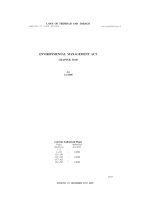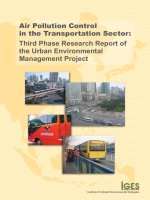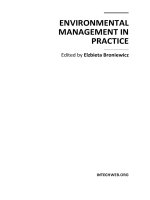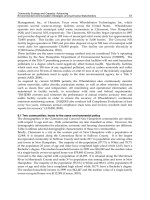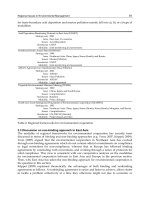Environmental management E363 lecture 4 soil
Bạn đang xem bản rút gọn của tài liệu. Xem và tải ngay bản đầy đủ của tài liệu tại đây (91.48 KB, 18 trang )
E363 –
ENVIRONMENTAL MANAGEMENT
LECTURE 4 - SOIL
Dr. Nguyen Thi Hoang Lien
WHAT IS SOIL?
• Soil is a mixture of minerals, air, water, and
organic materials, such as roots, decaying
plant parts, fungi, earthworms, bacteria, and
microorganisms.
• An acre of healthy topsoil can contain 900
pounds of earthworms, 2,400 pounds of fungi,
1,500 pounds of bacteria, 133 pounds of
protozoa, 890 pounds of arthropods and
algae, and in some cases, small mammals
(Sullivan, Preston. “Sustainable Soil Management: Soil Systems
Guide”. ATTRA National Sustainable Agriculture Information Service.
National Center for Appropriate Technology (NCAT). May 2004).
ORGANIC MATTER
• Any part of a plant or animal, either living or
dead - leaves, roots, sticks, fruit, seeds,
worms, insects, manure, and food scraps are
all examples of organic matter.
• The decomposition of organic matter
provides soils with the nutrients required by
plants to grow.
• Organic matter also improves soil structure,
and helps the soil to retain more water.
THE ISSUES
“A nation that destroys its soils destroys
itself.” - Franklin D. Roosevelt (Letter from
President to Governors. White House,
Washington DC. February 26, 1937)
Healthy soils are essential for the production
of crops used to feed humans and livestock. In
addition to providing a stable base to support
plant roots, soils store water and nutrients
required for plant growth.
INDUSTRIAL AGRICULTURE
Industrial agriculture practices continue to
damage and deplete this valuable natural
resource. While intensive plowing and
monocrop agriculture systems have caused
nutrient depletion and wide-scale soil erosion,
over-application
of
fertilizers
and pesticides have contaminated our soils
and polluted our waterways.
SOIL EROSION
• Erosion is the movement of soil by water,
wind, or gravity.
• Although this process occurs naturally
throughout the world, industrial farming
practices have dramatically increased the
speed at which agricultural soils are eroded.
• The rate of erosion is highest when soil is not
covered by a protective layer of plants or
decaying organic matter.
• Industrial farmland is particularly susceptible
to erosion due to intensive tillage (plowing),
which eliminates protective ground cover from
the soil surface and destroys root systems that
help hold soil together.
• Since soil formation is an extraordinarily slow
process, erosion poses a serious problem; soil
erosion can quickly cause fertile farmland to
become unsuitable for agriculture. In extreme
cases, erosion can lead to desertification, a
process which causes arid soil to become
barren and incapable of sustaining plant
growth for many years.
• Even low rates of soil erosion can severely
damage agricultural land; not only does
erosion reduce the water holding capacity of a
given soil, it also strips away nutrients and
organic matter. In fact, soil removed by
erosion contains about 3 times more nutrients
and 1.5 to 5 times more organic matter than
the soil that remains behind.
• In addition to removing valuable soil from
farmland, erosion pollutes waterways with
sediment.
• Runoff containing sediment degrades aquatic
ecosystems by reducing stream depth and
increasing turbidity (making water cloudier),
causing the population of fish and other
aquatic organisms to decline.
• Eroded sediment also affects humans by
disrupting drainage systems, increasing the
cost of water treatment, filling up reservoirs,
and obstructing waterways.
• Furthermore, wind erosion damages buildings
and covers roads, railways, and other
structures with soil.
SOIL NUTRIENTS AND FERTILIZERS
In order to grow, plants require a variety of
different nutrients:
Boron (B)
Manganese (Mn)
Calcium (Ca)
Molybdenum (Mo)
Carbon (C)
Nitrogen (N)
Chlorine (Cl)
Oxygen (O)
Copper (Cu)
Phosphorus (P)
Hydrogen (H)
Potassium (K)
Iron (Fe)
Sulfur (S)
Magnesium (Mg)
Zinc (Zn)
• In natural environments such as prairies and
forests, plants obtain most necessary nutrients
from minerals found within the soil. When these
plants die, they fall to the ground, decompose,
and release nutrients back into the soil, making
them available for new plants. In this way,
nutrients are "recycled" with each generation of
plants.
• On farms, since crops are continually harvested
or eaten by grazing livestock, there is no steady
supply of decaying plant material to replenish
nutrient levels within the soil. Instead, nutrients
must be restored by adding fertilizers to the soil.
• Traditionally, agricultural soils were fertilized
using livestock manure, which is rich in
nutrients and organic matter. Farmers also
practiced crop rotation, regularly alternating
the types of crop grown in various fields and
periodically allowing fields to remain
unplanted. This process enables organic
matter to accumulate and decompose, thus
restoring nutrients to the soil.
• Industrial agriculture has dramatically altered the
nutrient management practices used on farms.
Modern industrial farms no longer raise animals and
crops together; instead, livestock are raised on
enormous CAFOs, and crops are mass-produced on
separate farms.
Although CAFOs generate tremendous amounts
of manure, it is too costly to transport this manure to
other cropland for use as fertilizer. In order to avoid
the expense of treating or transporting this animal
manure, CAFO's typically store the waste in huge
open-air pits, or "lagoons," and eventually spray the
untreated liquid manure onto surrounding land.
• Instead, today's large-scale industrial farms
depend on synthetic (manmade) chemical
fertilizers to support high-intensity monocrop
systems. Unfortunately, synthetic fertilizers are
often over-applied to cropland. In fact, it is
estimated that only about half of all fertilizers
are actually absorbed by plants; the remaining
chemicals pollute the atmosphere, soils, and
waterways (Tilman, David. “The Greening of the Green Revolution.”
Nature. Vol. 396. November 19, 1998.)
• The over-application of synthetic fertilizers and
manure both contribute to the growing
problem of nutrient pollution.
NUTRIENT POLLUTION
• Nutrient
pollution
damages
aquatic
ecosystems by stimulating the rapid growth of
algae. This reduces the aesthetic and
recreational values of waterways, and harms
many other living organisms. When the algae
die, the process of decomposition uses oxygen
dissolved within the water - this oxygen
depletion eventually kills fish and other
aquatic organisms.
• Nutrient pollutants washed from agricultural soils
also degrade coastal environments.
• Excess nutrients degrade coral reefs and seagrass
beds, reduce aquatic biodiversity, induce algal
blooms, and cause tremendous fish kills.
• Nutrient pollution is also thought to induce
outbreaks of Pfiesteria. This toxic dinoflagelate (type
of algae) emits a toxin that breaks down the skin
tissue of fish, causing bleeding sores or legions.
Pfiesteria outbreaks have caused major fish kills
and are thought to cause memory loss, confusion,
respiratory problems, and skin problems in humans.
NUTRIENT POLLUTION AND
HUMAN HEALTH
• Nutrient pollution also affects human health by
contaminating local water supplies.
• Nitrogen-contaminated groundwater is harmful
to humans, particularly to vulnerable
populations such as children, the elderly, and
people who have suppressed immune systems.
• Infants who drink water contaminated with
nitrates can suffer from methemoglobinemia, or
blue baby syndrome, a condition that can cause
brain damage or death.
LAW AND REGULATIONS
• QCVN 03:2008/BTNMT: National technical
regulation on the allowable limits of heavy
metals in the soils.
• QCVN 15:2008/BTNMT: National technical
regulation on the pesticide residues in the
soils.




